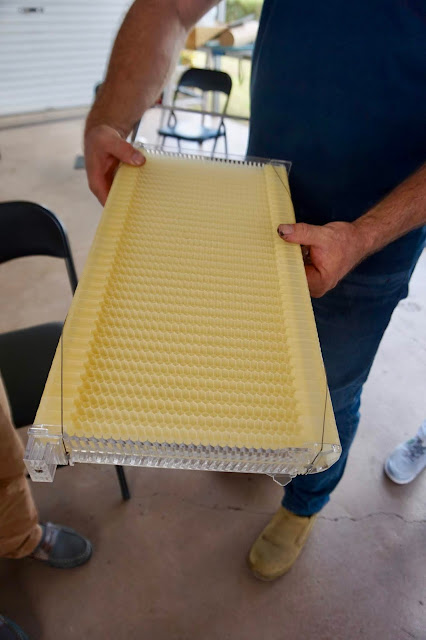This week we went to a Bee Hive Demo given by the knowledgeable Darryl and his wonderful wife Wendy. We were treated to bee treats for Morning Tea and then bee hives were explained, layer by layer. Starting from the brood box and the all important Queen who will lay the eggs, to the collection of nectar, the swallowing and regurgitation of the nectar, by the worker bees and the formation of the honeycombs.
There is a lot to think about, from the health of your brood box, to the flowering plants and trees within reach of our bees, to the feeding of the baby bees and who becomes what, drones, workers, queens. The dos and don'ts of beehive maintenance and the success of the hive.
For those of you living in Australian don't miss the Great Australian Bee Challenge which you can catch on IVIEW https://iview.abc.net.au/show/great-australian-bee-challenge a two part film where four groups took on the challenge of keeping a bee hive with no prior knowledge or experience. The results may surprise you.
We listened attentively to Darryl and then donned our hats and went off to look at some of his hives. He has 35- some are the old traditional bee hives and some are the newer Flow Hives. We saw them both in operation and it is only when you see them side by side, you begin to understand how revolutionary a change it was when Flow Hives hit the market.
A full flow Frame
C pretending he is a strong man- see the keys extending from the frame.
We watch a baby bee being born - they are lighter than the rest.
One of the frames full of honey having the wax scraped off its surface
The centrifugal drum in which the frames are placed with a tap at the bottom to sieve and extract the honey.
Flow Hive is a Queensland invention of a father and his son, https://www.honeyflow.com.au after many years of thought and practice. The frame is formed in a hexagonal pattern but which allows movement by means of a key which slightly twists the hexagons within the frame. When they are aligned the bees form the honeycombs within the hexagons. When the key is turned then this alignment breaks up and allows the honey to freely flow out of a tap.The key is then turned back and the alignment is once more in place allowing the bees to continue with the production of the honey comb and honey. This method is far less destructive and easier for harvesting the honey. In the time we were there, we turned the key on one small frame and then went off to visit the other hives. This is the start with a drop of honey in the jar. The adjoining photo shows how much honey collected in the short time of the demonstration.
The first drop of honey once the key was turned and the jar at the end of the demonstration/
We loved everything we learnt about bees. We were amazed by their intelligence, ability to reproduce at will, organise and inform. The bees have a special "waggle" dance and depending on the waggles they can inform their other co workers where a source of pollen and nectar can be found. They are industrious women! We wont speak about the men, who are relegated really to being sperm donors. Sadly, their fate is sealed once they have mated with a queen!















No comments:
Post a Comment
Leave a comment :)